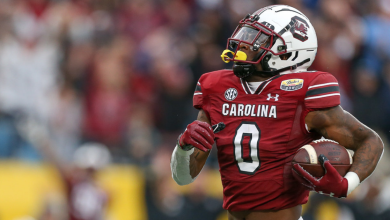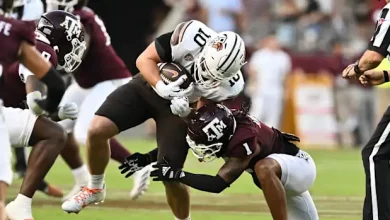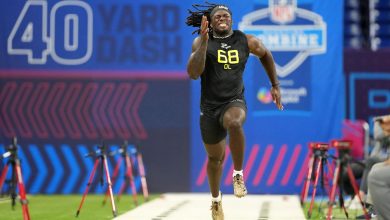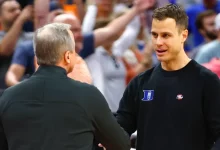Miami Dolphins offensive lineman Bayron Matos sustained an unspecified injury during Wednesday’s practice and was transported to a hospital via helicopter for medical evaluation and treatment.
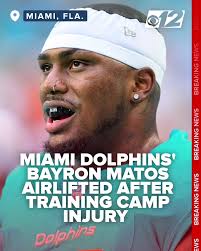
The injury sustained by Miami Dolphins offensive lineman Bayron Matos during Wednesday’s practice has garnered attention not only because of its immediate impact on the team’s roster but also due to the circumstances surrounding the injury and the response measures taken. When an athlete is injured on the field, especially in a high-contact sport like football, it prompts a multifaceted discussion encompassing medical protocols, team preparedness, player safety, and the broader implications for the sport. This analysis delves into the incident’s details, medical considerations, safety protocols, team response, and the importance of athlete health management, painting a comprehensive picture of what transpired and its significance.
The Incident: What Happened?
On a routine practice day for the Miami Dolphins, Bayron Matos, an offensive lineman, suffered an undisclosed injury towards the end of the session. The specifics of how the injury occurred remain unpublicized, which is common in ongoing investigations or privacy considerations, but the severity was enough to warrant urgent medical attention. Following the injury, the team acted swiftly by arranging for Matos to be transported to a hospital via helicopter, a decision indicative of the seriousness of his condition or the need for immediate, specialized medical assessment.
This incident underscores the unpredictable and sometimes perilous nature of football, where even during practice—a controlled environment—injuries can occur unexpectedly. The physicality of the sport, combined with the high-speed collisions and exertion, inherently carries risks, making safety protocols, medical readiness, and quick response mechanisms vital.
Immediate Medical Response and Transport
The decision to airlift Bayron Matos to a hospital reflects best practices in sports medicine when dealing with potentially serious injuries. Helicopter transport, or aeromedical evacuation, is often employed when:
The injury is suspected to involve head, neck, or spinal trauma.
The injury appears life-threatening or could result in permanent disability if not addressed promptly.
The location of the injury is remote or inaccessible by ground ambulance in a timely manner.
The patient’s condition necessitates rapid transfer for advanced diagnostic imaging, surgical intervention, or specialized care.
In this case, the Dolphins’ medical team likely recognized the potential gravity of the injury, prompting the emergency helicopter dispatch. Such decisions are made based on protocols that prioritize athlete safety above all else, emphasizing the importance of rapid assessment, stabilization, and transportation.
Medical Considerations and Protocols
When an athlete sustains an injury during practice, medical teams follow established protocols to assess and manage the situation. These include:
Initial Assessment: Immediate evaluation of consciousness, airway, breathing, and circulation (the ABCs). If the athlete is unresponsive or shows signs of severe trauma, immobilization and stabilization take precedence.
Spinal Precautions: Given the risk of neck or spinal injuries in contact sports, immobilization using cervical collars and backboards is standard until imaging confirms safety.
Neurological Evaluation: Checking for signs of neurological damage—loss of sensation, movement deficits, or altered mental status—is crucial.
Imaging and Diagnosis: Once stabilized, imaging techniques such as X-rays, CT scans, or MRIs are employed to determine the injury’s extent.
Treatment and Recovery: Based on findings, treatment ranges from conservative management (rest, physical therapy) to surgical intervention.
In the case of Matos, the undisclosed nature of the injury suggests that the team and medical staff opted to keep details private, possibly pending further evaluation. The use of a helicopter indicates potential concern for spinal or head injury, which requires careful assessment and often advanced imaging.
The Role of Player Safety in Professional Football
Bayron Matos’ injury incident highlights the ongoing importance of player safety initiatives in the NFL and other professional sports leagues. Over the years, leagues have implemented various measures to reduce injury risk, including:
Improved helmet technology to mitigate head injuries.
Stricter protocols on concussion management.
Enhanced padding and protective gear.
Rule changes to minimize dangerous contact.
Mandatory medical examinations post-injury.
Emphasis on proper tackling techniques.
Despite these measures, injuries remain an inherent part of the sport, emphasizing the need for continuous research, innovation, and vigilance. The league’s medical teams, trainers, and coaching staff play vital roles in ensuring prompt, effective responses when injuries occur.
The Impact on the Miami Dolphins
The injury of a key player like Matos can have several immediate and long-term implications for the team:
Roster Adjustments: The team may need to bring in temporary replacements or shuffle existing players to fill the gap.
Game Planning: Coaches might adjust game strategies depending on the injured player’s role and recovery prospects.
Team Morale: Such incidents can affect team morale, emphasizing the importance of mental resilience and support.
Injury Management: The coaching staff and team medical personnel will monitor Matos’s recovery closely, working with specialists to facilitate optimal healing.
The Dolphins’ management will likely keep the injury updates private to maintain focus and prevent unnecessary speculation, but the priority remains the player’s health and swift recovery.
Broader Implications for Player Health and Safety
This incident serves as a reminder of the importance of rigorous medical protocols and continuous safety improvements in American football. It also underscores the need for:
Enhanced Protective Equipment: Technologies that better absorb impacts and reduce injury severity.
Medical Readiness: Ensuring medical teams are well-trained, equipped, and prepared for rapid response.
Player Education: Teaching athletes about injury risks and encouraging reporting of symptoms without fear of repercussions.
Post-Injury Care: Developing comprehensive recovery programs that address physical and mental health needs.
In recent years, the league has increased its focus on concussion protocols and injury prevention strategies, but incidents like Matos’ injury demonstrate that there is always room for improvement.
The Psychological and Emotional Aspects
Injuries, especially sudden and severe ones, also have psychological impacts on athletes. The uncertainty about recovery, concerns about career longevity, and the mental toll of injury can be profound. Support systems, including counseling and mental health resources, are vital components of athlete care.
The Dolphins’ medical and coaching staff will likely provide psychological support to Matos, helping him navigate the recovery process and reintegration into the team. This holistic approach to athlete health recognizes that physical recovery is intertwined with mental well-being.
The Future: Monitoring and Prevention
Following such incidents, teams and leagues analyze injury data to identify patterns and potential risk factors. Advances in sports science, biomechanics, and data analytics contribute to better understanding injury mechanisms, leading to improved preventive measures.
For example, research into impact forces, player biomechanics, and equipment efficacy can inform future safety protocols. Additionally, fostering a culture that prioritizes player health over aggressive play can reduce injury rates.
A Collective Responsibility
Bayron Matos’ injury at practice underscores the unpredictable and hazardous nature of professional football, despite rigorous safety measures. The prompt decision to airlift him to a hospital reflects a commitment to athlete safety and adherence to medical protocols. Moving forward, the incident emphasizes the ongoing need for technological advancements, safety improvements, and a supportive environment for injured players.
Ultimately, safeguarding athlete health is a collective responsibility shared by leagues, teams, medical professionals, and players themselves. By continuously evolving safety standards, investing in medical research, and fostering a culture of care, the sport can better protect its athletes and ensure that, when injuries occur, they are managed with the utmost professionalism and compassion. Bayron Matos’ situation serves as a reminder of this shared duty and the importance of preparedness, swift action, and ongoing commitment to athlete well-being.



